
XXXI Simpósio Brasileiro de Telecomunicações
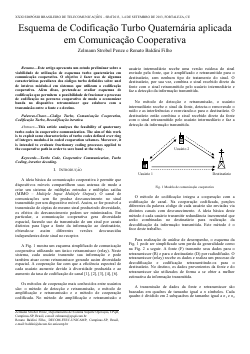
Esquema de Codificação Turbo Quaternária aplicada em Comunicação Cooperativa
Zelmann Strobel Penze, Renato Baldini Filho
DOI: 10.14209/sbrt.2013.215
Keywords: Turbo Code Cooperative Communication Turbo Coding iterative decoding
Abstract
Zelmann Strobel Penze ,Renato Baldini FilhoDownload
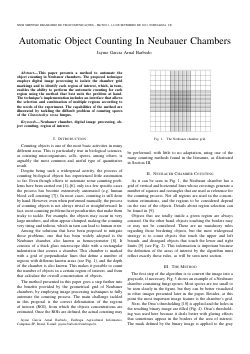
Automatic Object Counting In Neubauer Chambers
Jayme Garcia Arnal Barbedo
DOI: 10.14209/sbrt.2013.224
Keywords: Neubauer chamber digital image processing object counting region of interest
Abstract
This paper presents a method to automate the object counting in Neubauer chambers. The proposed technique employs digital image processing to isolate the chamber grid markings and to identify each region of interest, which, in turn, enables the ability to perform the automatic counting for each region using the method that best suits the problem at hand. The technique’s implementation includes an interface that allows the selection and combination of multiple regions according to the needs of the experiment. The capabilities of the method are illustrated by tackling the difficult problem of counting spores of the Clonostachys rosea fungus.Download
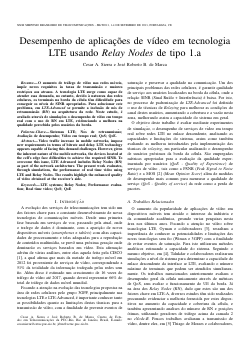
Desempenho de aplicações de vídeo em tecnologia LTE usando Relay Nodes de tipo 1.a
Cesar A. Sierra, Jose Roberto B. de Marca
DOI: 10.14209/sbrt.2013.3
Keywords: LTE systems Relay Nodes Performance evaluation Real time video QoS QoE
Abstract
Video traffic increase in mobile networks, impose new requirements in terms of bitrate and delay. LTE technology appears capable of facing this demand challenges. However, given the inherent nature of the mobile networks, the devices located at the cell’s edge face difficulties to achieve the required SINR. To overcome this issue, LTE Advanced includes Relay Nodes (RN) as part of the network architecture. The present work evaluates, through simulations, the performance of real time video using LTE and Relay Nodes. The results highligh the enhanced quality of video obtained at the receiver’s side.Download
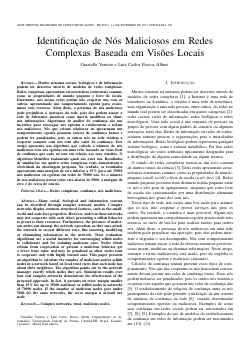
Identificação de Nós Maliciosos em Redes Complexas Baseada em Visões Locais
Grazielle Vernize, Luiz Carlos Pessoa Albini
DOI: 10.14209/sbrt.2013.237
Keywords: Complex networks trust malicious nodes.
Abstract
Many social, biological and information systems can be described through complex network models. Complex networks display common structural features, such as the smallworld and scale-free properties. However, nodes in these networks may not cooperate with each other, presenting a selfish behavior to preserve their resources. Furthermore, the presence of malicious nodes can damage the network operation, as they may attack the network in several different ways, like inserting, modifying or eliminating information in the network. Trust evaluation algorithms are a useful incentive for encouraging selfish nodes to collaborate and for isolating malicious ones. Nodes which refrain from cooperation or present a malicious behavior get a lower trust value and may be penalized as other nodes tend to cooperate only with highly trusted ones. This paper presents an algorithm to calculate the number of malicious and/or selfish nodes in a network based on local trust views that each node has about their neighbors. The algorithm points out to the network manager exactly which nodes they are. Simulation results over four real complex networks demonstrate the effectiveness of the proposed approach. In fact, it presents an error margin smaller than 15% for up to 35000 malicious or selfish nodes in networks of 70000 nodes. If the number of malicious nodes goes under 5000 for the same networks, the error margin is around one node.Download
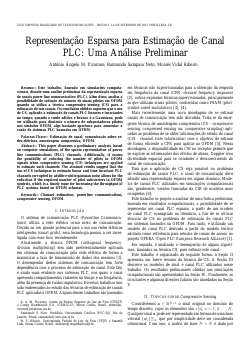
Representação Esparsa para Estimação de Canal PLC: Uma Análise Preliminar
Antônio Angelo M. Picorone, Raimundo Sampaio Neto, Moisés Vidal Ribeiro
DOI: 10.14209/sbrt.2013.11
Keywords: Channel estimation powerline communications compressive sensing OFDM.
Abstract
This paper discusses a preliminary analysis, based on computer simulations, of the sparse representation of power line communications (PLC) channels. Additionally, it exams the possibility of reducing the number of pilots in OFDM signals when compressive sensing (CS) techniques are applied to estimate such channels. The attained results suggest that the use of CS techniques to estimate linear and time invariant PLC channels corrupted by additive white gaussian noise allows for the reduction if the required number of pilot subcarriers in OFDM symbols, which is a timely issue for increasing the throughput of PLC systems based on OFDM schemes.Download
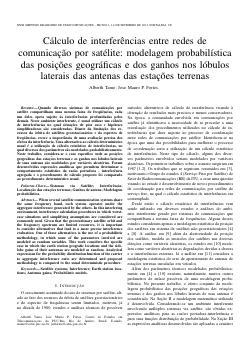
Cálculo de interferências entre redes de comunicação por satélite: modelagem probabilística das posições geográficas e dos ganhos nos lóbulos laterais das antenas das estações terrenas
Alberth Tamo, Jose Mauro P. Fortes.
DOI: 10.14209/sbrt.2013.247
Keywords: Satellite systems Interference Earth station locations Antenna gains Probabilistic models
Abstract
When several satellite communication systems share the same frequency band, each system operates under the aggregate interference generated by the others. In this interfering environment, interference calculation procedures in which worstcase situations and simplifying assumptions are considered are commonly used. Given that the geoestationary satellite orbit and the frequency spectrum are limited resources, it is important to consider alternatives that lead to a more precise interference evaluation. One of these alternatives is the use of a probabilistic methodology, in which some of the parameters involved are modeled as random variables. This work considers the specific case in which the earth station geografic locations and the sidelobe gains of their antennas are modeled as random. Analytical expressions for the probability distribution function of the carrier to aggregate interference ratio are determined and proposed methodology is compared to the usual deterministic procedureDownload

Efeito de modificações nas áreas de cobertura das alocações brasileiras do Plano de Serviço de Radiodifusão por Satéline da UIT no ambiente interferente do Plano
Américo A. Rubin de Celis Vidal, José Mauro P. Fortes
DOI: 10.14209/sbrt.2013.29
Keywords: Interference overall equivalent protection margin satellite communications
Abstract
The use of gestationary, allowed for a large development in long distance communications and broadcasting. Since the geostationary satellite orbit (GSO) is limited resource, there is motivation for a priori planning of the use of this resource so that access to the GSO is guaranteed to all countries. These a priori planning involve studies, analysis and modeling that depend of the specific characteristics of the systems being planned. Motivated by specific interests of the Brazilian administration, this work presents a precise analysis of the effect that changes in the technical parameters of the Brazilian allocations in the ITU Bradcasting Satellite Service Plan would have on the interferences generated and experienced by the systems in the Plan.Download
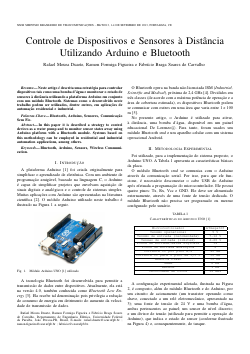
Controle de Dispositivos e Sensores a Distância Utilizando Arduino e Bluetooth
Rafael Moura Duarte, Ramon Formiga Figueira, Fabrício Braga Soares de Carvalho
DOI: 10.14209/sbrt.2013.30
Keywords: Bluetooth Arduino Sensors Wireless Communication
Abstract
In this paper it is described a strategy to control devices as a water pump and to monitor sensor states away using Arduino platform with a Bluetooth module. Systems based on this methodology can be employed in residential and industrial automation applications, among othersDownload
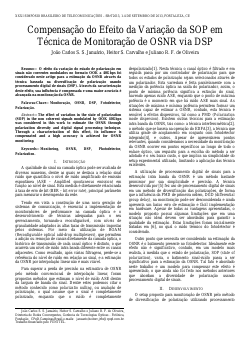
Compensação do Efeito da Variação da SOP em Técnica de Monitoração de OSNR via DSP
João Carlos S. S. Januário, Heitor S. Carvalho, Juliano R. F. de Oliveira
DOI: 10.14209/sbrt.2013.238
Keywords: Monitoring OSNR DSP Photodetector Polarization
Abstract
The effect of variation in the state of polarization (SOP) in the non coherent signals modulated by OOK 40Gbps was considered in this work to estimate the OSNR through polarization diversity and digital signal processing technique. Through a characterization of this effect, its influence is compensated and a high accuracy is achieved for OSNR monitoringDownload
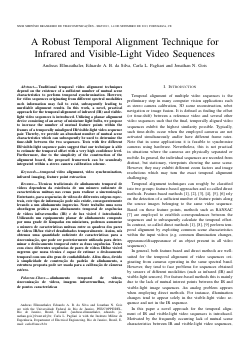
A Robust Temporal Alignment Technique for Infrared and Visible-Light Video Sequences
Andreas Ellmauthaler, Eduardo A. B. da Silva, Carla L. Pagliari, Jonathan N. Gois
DOI: 10.14209/sbrt.2013.48
Keywords: temporal video alignment video synchronization infrared imaging feature point extraction
Abstract
Traditional temporal video alignment techniques depend on the existence of a sufficient number of mutual scene characteristics to perform temporal synchronization. However, for video sequences originating from different spectral modalities such information may fail to exist, subsequently leading to unreliable alignment results. In this work, a novel, practical approach for the temporal alignment of infrared (IR) and visiblelight video sequences is introduced. Utilizing a planar alignment device consisting of an array of miniature light bulbs, we propose to increase the number of mutual feature points within the frames of a temporally misaligned IR/visible-light video sequence pair. Thereby, we provide an abundant number of mutual scene characteristics which can subsequently be used to determine the time-shift between the two sequences. Tests with five different IR/visible-light sequence pairs suggest that our technique is able to estimate the temporal offset with a very high confidence level. Furthermore, due to the simplicity of the construction of the alignment board, the proposed framework can be seamlessly integrated within a stereo camera calibration scheme.Download